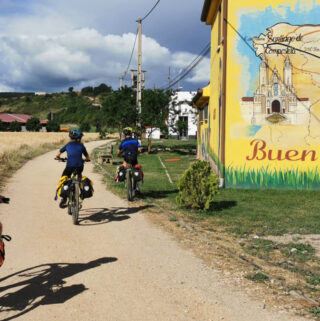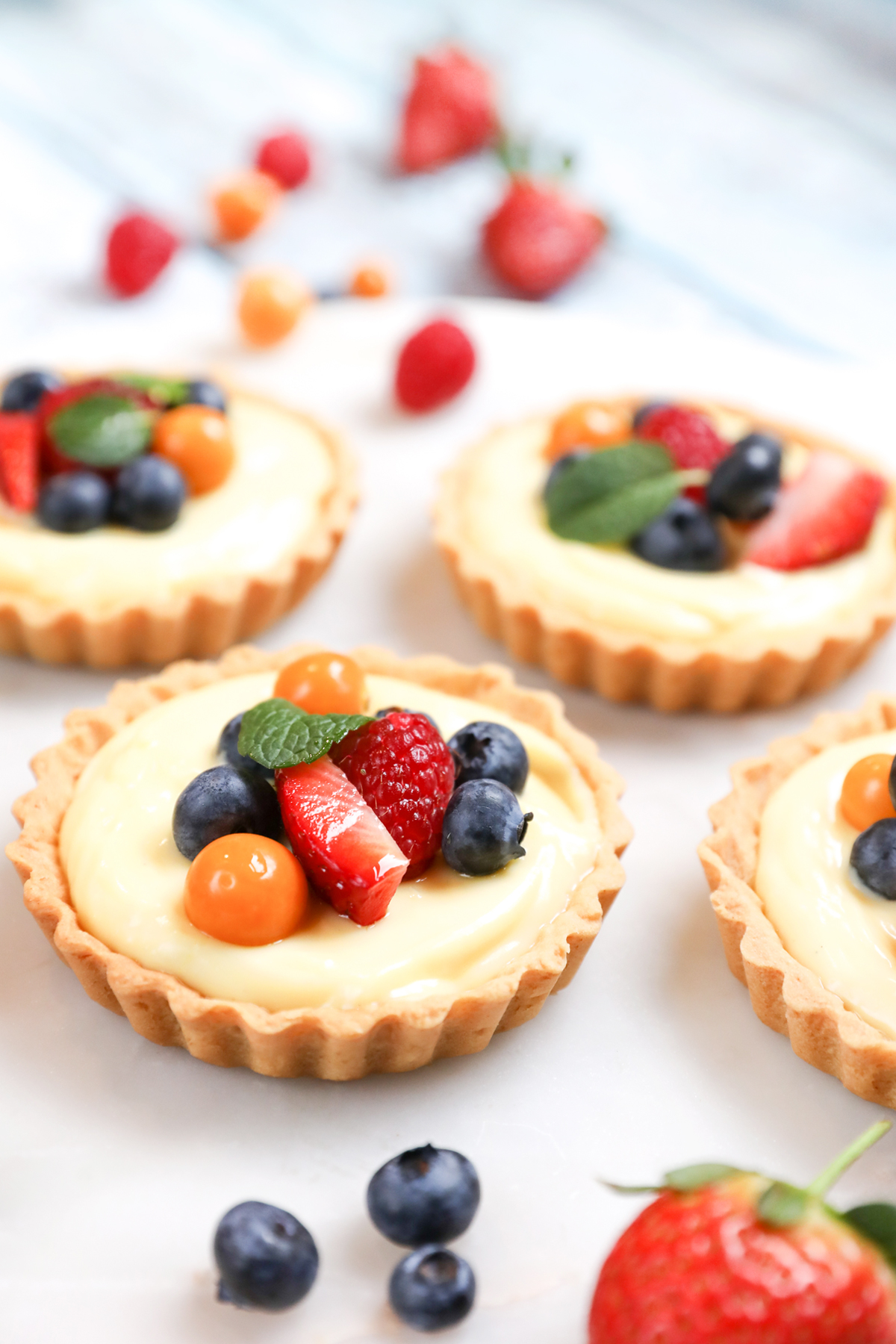
Happy Spring day beautiful people! I like to celebrate the start of spring with a cake or tart, something summery to set the tone for the glorious warm days to come. Now, Custard Tarts topped with berries are just the thing I had in mind but they felt very intimidating. They were the kind of thing I would always buy at a patisserie or farmers market, but never consider actually making.
But not anymore BABY! Two weeks ago, I got all pumped up for it, got a recipe, rolled up my sleeves and gave it a bash. Yeah!
It was a total flop.
The custard was excessively sweet and too yellow. Just not the right hue, you know. And the base, well, I almost needed a paint scraper to get it out the dish. So ultimately is was the perfect benchmark for what you don’t want a custard tart to look or taste like.
I then gave it another bash with a new recipe. And this time, I got lift-off. It was really just a case of finding a recipe with Parisian roots. Because, let’s face it, Custard Tarts give off that air of “only made by chefs who went to pastry school in Paris”, hence, the recipe I used second time round, was from a women who went to pastry school….in Paris.
The ingredients you see below are unchanged from the original recipe but the method has been re-explained by moi, a beginner, to you (who may also be a beginner) with basic tips that I felt would be useful for a beginner.
I think if you’re just starting out making custard tarts, make BABY ones, (also called tartlets or tartelettes in French). There is less surface area to work with and it’s all just easier to handle plus you get to practice placing and shaping the pastry in the pans, several times.
The custard or crème patisserie (or traditional pastry cream as it is also known) is a delight to make, it is super easy and comes out pale yellow (much better color palette) and subtly sweet – it only has 2 tablespoons of sugar. You can taste the Vanilla and it’s just perfect. Understated yet Sophisticated, dahhling!
The most important rules when making the custard are to: Be patient, use low heat and whisk continuously. The low heat helps to prevent the delightful mixture, from becoming a burnt or curdled mixture. We want to temper the ingredients to get a lovely silky custard. The custard will start to thicken all of a sudden, so be prepared for it as one minute it feels like water and the next a custard so keep WHISKING. We don’t want lumps or bumps. Finally, as soon as it starts to boil, count 30 seconds and then remove from the heat. Stir in the butter if you opt to do so and allow to cool.
The custard can be used for so many things besides these tarts, such as:
- a filling in between cakes
- custard slices
- custard doughnuts
- Even if you just want creamy homemade custard – this is the recipe for all of that.
Read through the instructions before going ahead. Don’t be put off by them, just go step-by-step. The ingredient lists are basic and straight-forward. Nothing fancy required, besides perhaps Vanilla Paste or a Vanilla Pod, which I would deem absolutely essential. Remember this recipe can be done in parts. You can make the bases on one day and the custard the next and then assemble the following day. It may feel a lot more manageable that way.
I used non-stick mini tart pans I bought online – they have removable bases so you can easily get the tarts out when needed and I would recommend trying to get them if you can.
Another important note: Dough needs to be cold so you can work with it easily and so that the butter won’t just melt as soon as it gets into the oven. This is BIG TIP number one for working with pastry and so you will see how many times I say place in the fridge, place in the fridge, and it is for good reason.
And just onto Frugal matters – you will have egg whites left over. Don’t throw them away! You can freeze them. Place the egg whites into a resealable freezer bag, label it, date it and freeze it flat (helps for a quicker thawing process). To thaw – place in the fridge overnight and then to use, follow this rule of thumb: 2 tablespoons egg white = 1 large egg white.
If however, you are in the mood for a baking marathon, you can always whip up some meringues using this recipe here!
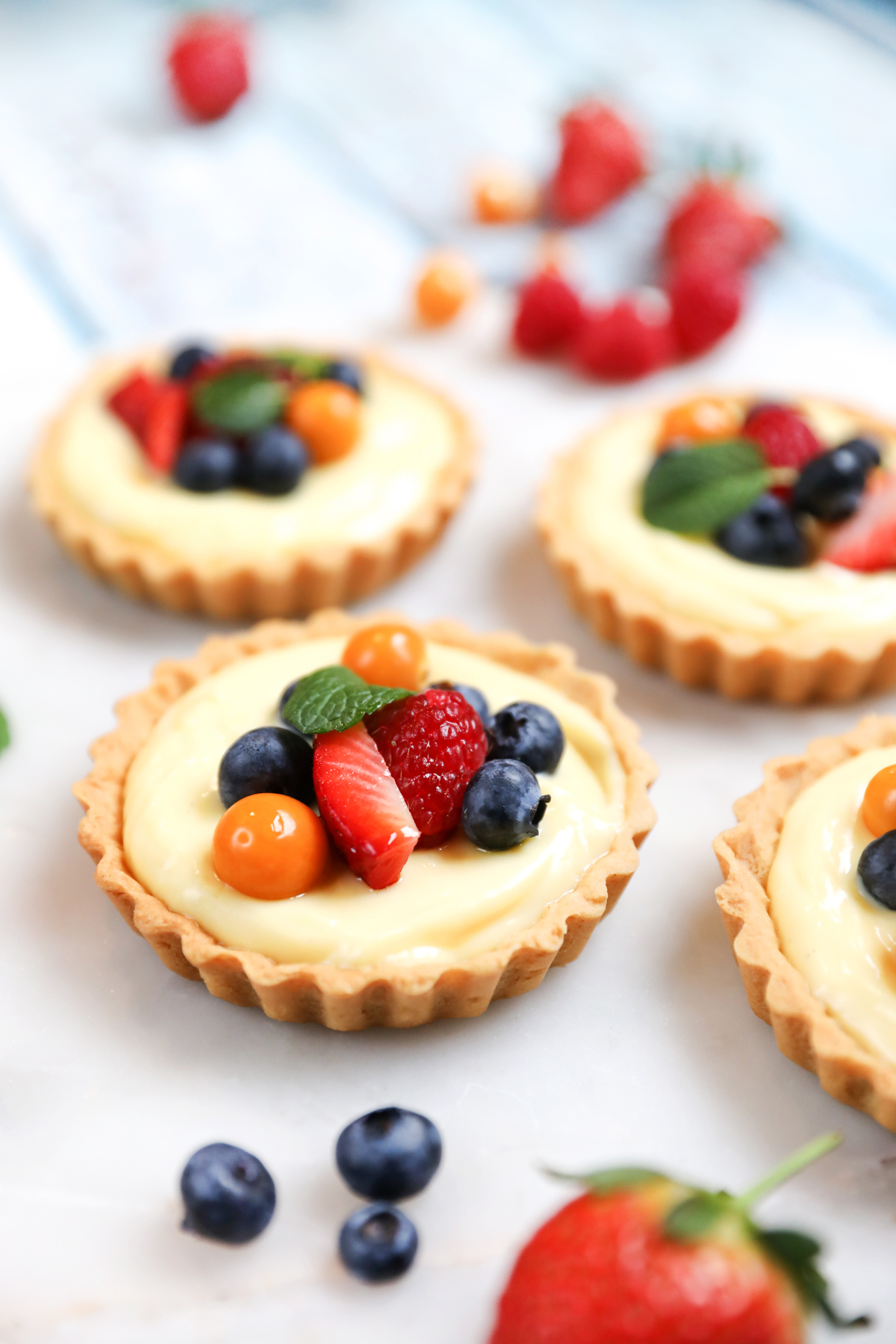
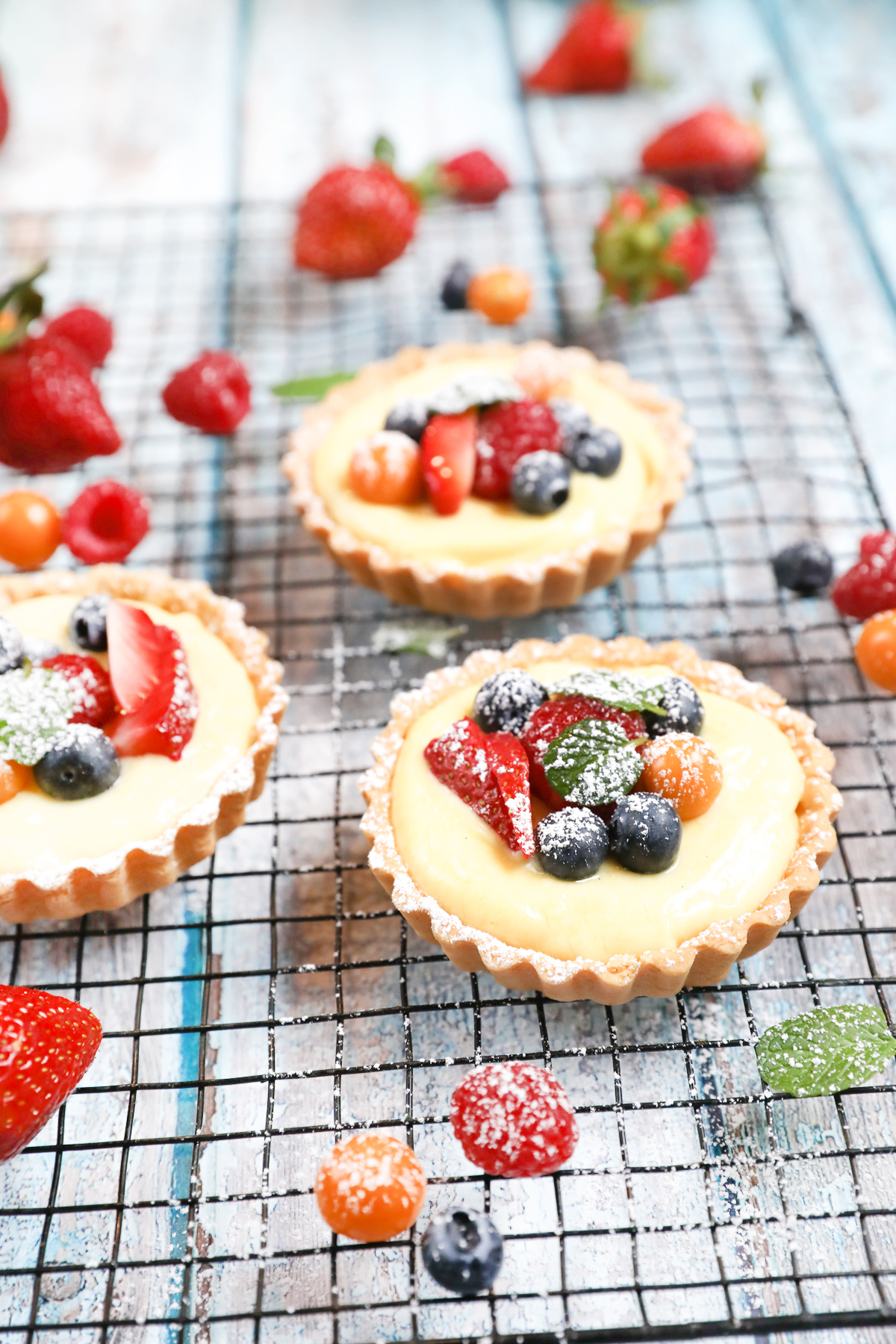

Mini Custard Tarts
 Prep Time: 2 hours
Prep Time: 2 hours Cook Time: 40 mins
Cook Time: 40 mins Total Time: 2 hrs 40 mins
Total Time: 2 hrs 40 mins Yield: 8 Mini Tarts 1x
Yield: 8 Mini Tarts 1x
Description
A tried and tested recipe to make homemade custard tarts. Offers step-by-step instructions to help you make perfect and tasty tarts.
Ingredients
Tart Shells
- 1 2/3 cup flour
- 1/2 cup icing sugar
- 1 pinch salt
- 1/2 cup ( 120g ) butter (must be cold)
- 1 egg, whisked
Traditional Pastry Cream (Custard or Creme Patissiere)
- 2 cups full cream milk
- 1/2 teaspoon Vanilla Paste or 1 Vanilla Bean with seeds scraped out
- 4 egg yolks
- 2 tablespoons Caster sugar
- 1/4 cup cornstarch
- 2 tablespoons butter (optional)
Instructions
Tart Shells
- You will need mini tart pans for this recipe. Alternatively, you could use mini cupcake tins. Make sure you are using non-stick pans or pans that have removable bases. Failing that, you can always just grease the pans with a little butter or non-stick spray.
- Make sure the butter is cold – cut into small blocks
- In a food processor, add the flour, icing sugar, salt and butter together. Pulse until the mixture resembles small crumbs. If you don’t have a food processor, you can use a handheld blender (this is what I did) which isn’t as efficient but at least easier than having to create crumbs by hand.
- Add the whisked egg and mix until a dough starts to come together, (don’t overmix), at which point you can remove the dough from the processor and form a ball using your hands.
- Place the dough between two pieces of baking paper and roll the dough to approximately 3mm thick. Place on a tray, keep covered and place in the fridge for at least 1 hour.
- Once the dough has chilled, remove the baking paper and place on a clean, lightly floured surface. You may want to roll out the dough a little more but I wouldn’t make it too much thinner than 3mm.
- For sizing, place a mini tart pan on the pastry, cut a circle approximately 2cm away from the base of the pan. That should be big enough to place in the pan, have it rise up the sides and a little to cut off too. Cut out as many bases as you from the sheet of dough. Bring the remaining dough together into a ball and then roll out again. If the dough feels too flimsy to work with, you may need to put it back in the fridge for 30 minutes.
- Slide the cut-out bases into the tins, gently pressing down the bottom edges first, then pressing the dough into the sides of the pan and then gently pressing the base of the dough to the base of the pan, making sure there are no air bubbles. Prick the bases of the tarts with a fork a few times and then place back in the fridge for 1 hour.
- Heat the oven to 16O°C or 320°F.
- Line each pastry with a small piece of scrunched up baking paper and cover with baking beads or rice or dried beans or even raw chickpeas. This helps to keep the pastry in place, and prevents it from losing shape and puffing up.
- Bake for 15 minutes and then remove the baking paper and weights and cook for another 10 or so minutes until lightly browned.
- Carefully remove bases as soon as possible and allow to cool completely before adding the filling.
Traditional Pastry Cream (Custard or Crème Patisserie)
- In a small pot, add the milk and vanilla paste and heat gently on the lowest setting – we simply want to infuse the milk with the vanilla pod / paste but we absolutely do not want to let this boil.
- In a separate, medium-sized pot, whisk the sugar and eggs until well combined.
- Now add the cornstarch (sieve to avoid lumps) to the sugar-egg mixture and whisk through until well combined.
- Slowly pour the warm milk over the egg-sugar-cornstarch mixture whilst continually whisking. Do this until well combined. We do this slowly so that the eggs don’t cook or curdle from the warm milk.
- Turn the stove on to low heat and continue to whisk the mixture until it starts to thicken – this may take anything from 20-30 minutes so be patient. It will start to thicken and then boil. As soon as it starts to boil, whisk for another 30 seconds and then remove from heat. (this time of 30 seconds would double if you doubled this recipe as it is based on the amount of milk – 30 seconds per 500ml milk)
- If you wanted an extra thick custard for whatever reason, I would simply allow it to boil for another 30 seconds.
- Remove the pot from the heat. If you’re adding the optional butter, stir the butter in now (away from the heat) and whisk until fully combined.
- Allow to cool for 2-3 minutes and then transfer to a wide casserole dish or similar and cover with cling/plastic wrap such that the cling wrap is pressed to the surface of the custard – this prevents a skin from forming on the custard. Oh YEAH!!!! Techniques baby, techniques!!
- Now you can place the custard in the fridge until it cools down completely.
- The custard can be kept in the fridge for up to 3 days max – longer than this and it will start to thin out. Before using, whisk the cream to smooth over any lumps that may have formed.
Assembling
- Once the tart shells and custard have cooled down, add a large dollop of custard to each tart shell, being careful not to overfill – you will need to judge this yourself depending on whether you plan to add fruit to the top or not. It doesn’t take the addition of too much fruit to make the custard spill over the top of the base, so just bear that in mind.
- Serve and enjoy immediately, why wait any longer!
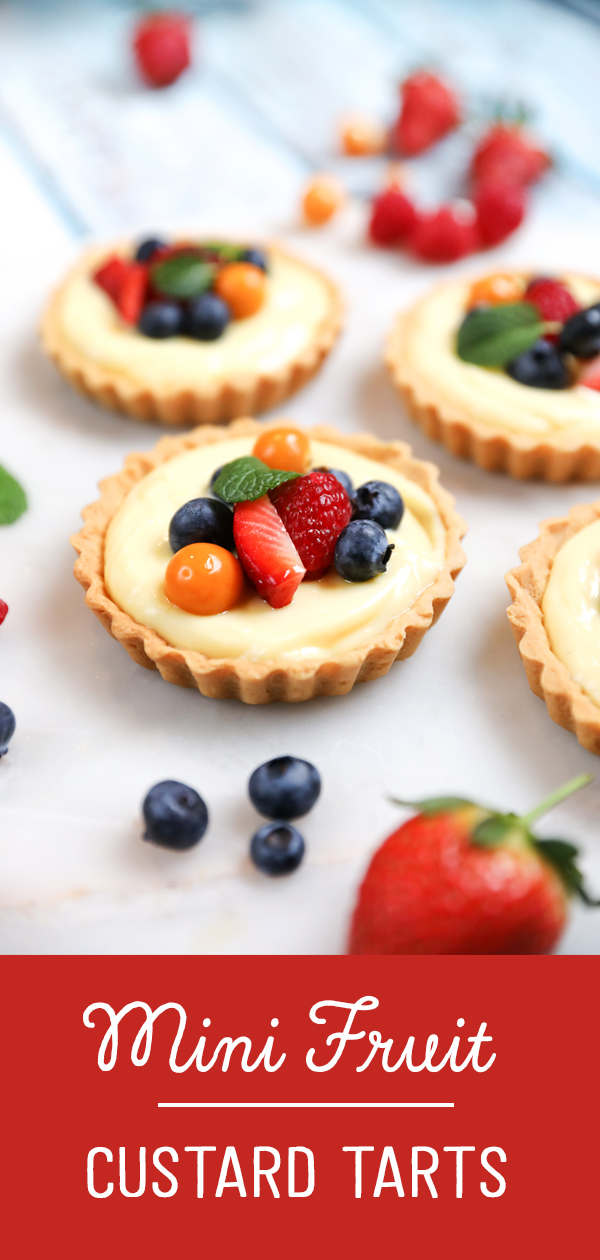
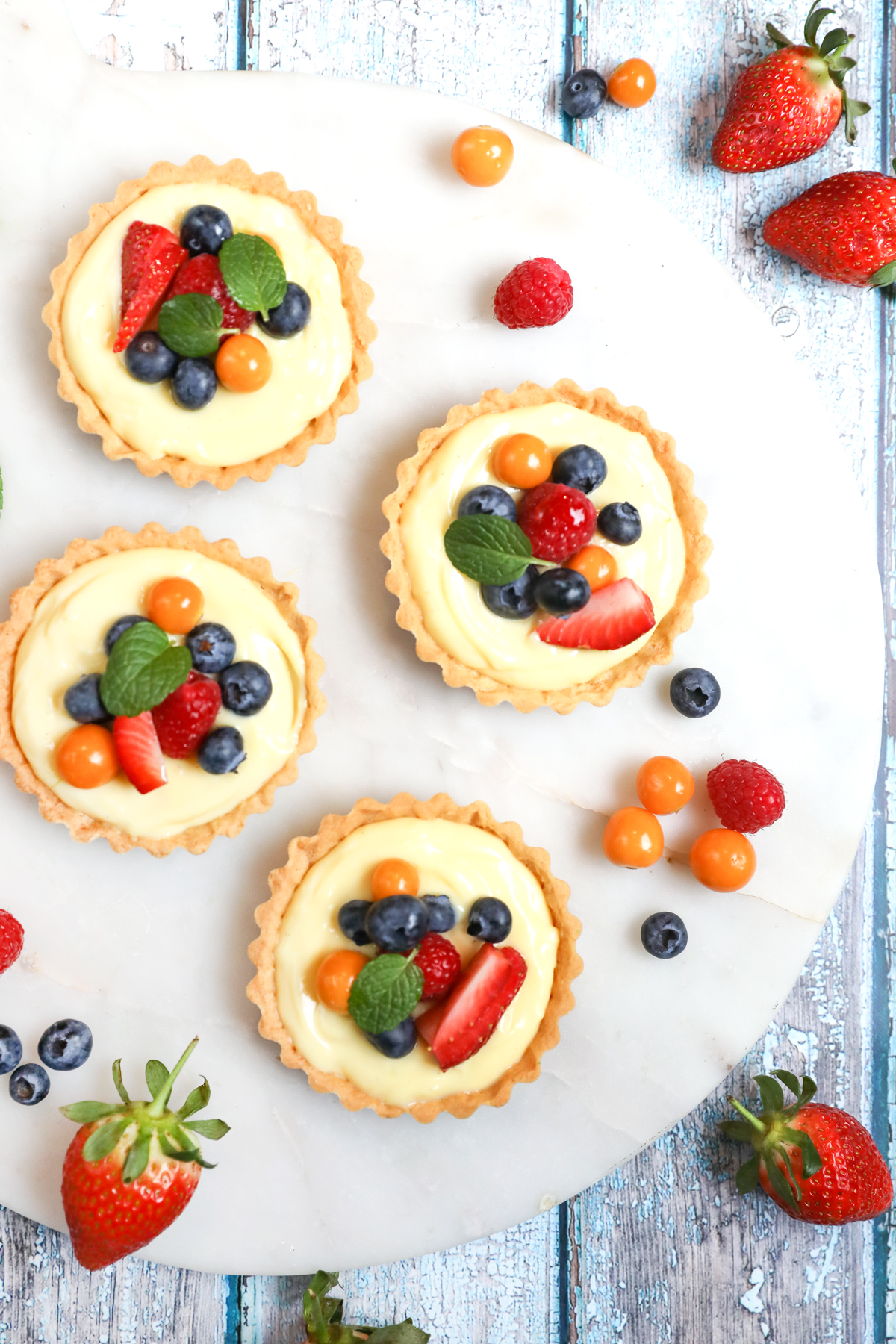
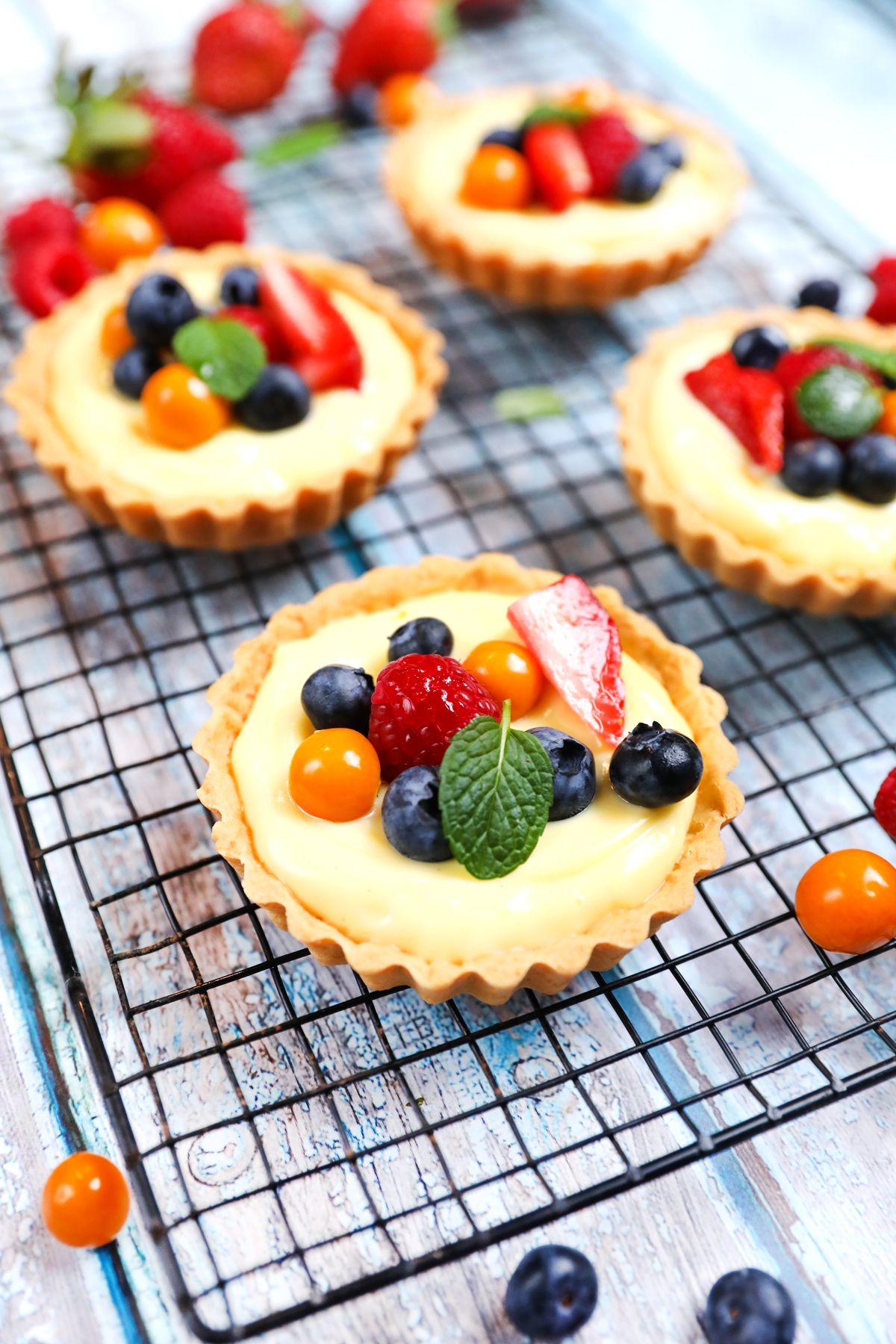
Reference: A Baking Journey



